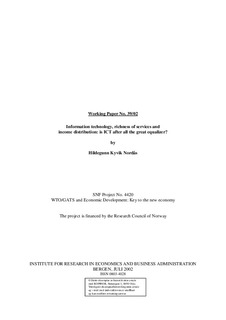| dc.description.abstract | This paper discusses how information and communication technology (ICT) affects the richness and reach of services such as education, health and entertainment. These services consist of several components, some of which can be digitized and transmitted over geographical distances. Digitization and transmission require an investment in ICT. A general equilibrium model is developed and numerical simulations in a stylized two-factor, two-region, center-periphery setting are presented. Diffusion of information technology, modeled as a reduction in the cost of digitizing and transmitting information over geographical distances, has a dramatic impact on skilled workers' wages in the periphery, both relative to unskilled workers in their own region and relative to skilled workers at the center. Trade in intermediate services improves the welfare of low-income groups in the periphery and leads to a more equal distribution of income both between the center and the periphery and within the periphery. | en |
